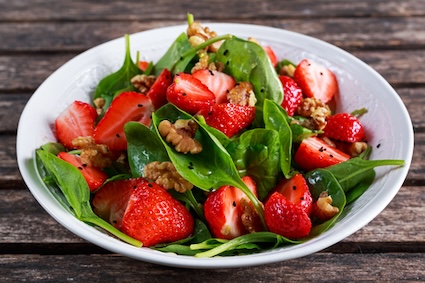Eating leafy greens offers big health benefits, but including these especially healthy veggies in your diet isn’t always easy. Seniors Guide writer Kari Smith provides an array of delicious ways to get your leafy greens on.
Leafy vegetables like spinach, kale, collards, and Swiss chard are rich in calcium, vitamin K, fiber, and antioxidants that support digestion, bone strength, heart health, immune function, and even cognitive health. They are also low in calories but nutrient-dense, making them a filling choice that may help reduce the risk of chronic illnesses such as heart disease and diabetes while helping maintain a healthy weight.
Get your leafy greens with these common options
Unless you’re in the habit of eating a lot of greens, sometimes it’s difficult to eat enough of them regularly. Incorporating a variety of leafy greens into your diet can be both nutritious and enjoyable. Here are some common leafy greens and tips on how to prepare them:
- Spinach: This versatile green rich in calcium, and vitamins A and K can be eaten raw in salads or cooked by steaming or sautéing. Don’t use it primarily as a source of iron, since the form of iron that it contains is poorly absorbed by the body.
- Kale: Slightly tougher than spinach, kale can be consumed both raw and cooked. Look for smaller leaves, or baby kale if you can find it. Keep in mind that steaming it is the best way to cook it while retaining nutrients. If you prefer it raw, remove the tough stems, and tear into small pieces to add to your other salad greens. I even enjoy making kale chips in my air fryer by tossing whole kale leaves in olive oil, then lightly topping with garlic salt.
- Swiss or rainbow chard: This colorful leaf is low in calories and high in magnesium, potassium, and vitamins A, C, and K. It can sautéed or added to soups and stews. Though it can be eaten raw in salads, it contains oxalates that may irritate sensitive stomachs.
- Collard greens: Commonly used in Southern cooking, collard greens are rich in fiber and calcium. They are best sautéed or simmered.
Here are eight ways to get your leafy greens
1. The most obvious – eat a salad
 For convenience, purchase your favorite base (baby spinach, spring mix, arugula, etc.) pre-washed and ready to eat. Add one or two veggies you love (like cherry tomatoes, cucumbers, or shredded carrots), and top with your favorite dressing. Adding nuts or seeds gives texture and a nutrient boost, while a sprinkle of cheese or beans can add protein. For example: make a simple Mexican salad by topping lettuce with shredded cheddar cheese, chopped green onions, black beans, and corn. Top with a zesty ranch dressing or even your favorite salsa! Craving something sweet? Check out this recipe for Kale and Strawberry Salad.
For convenience, purchase your favorite base (baby spinach, spring mix, arugula, etc.) pre-washed and ready to eat. Add one or two veggies you love (like cherry tomatoes, cucumbers, or shredded carrots), and top with your favorite dressing. Adding nuts or seeds gives texture and a nutrient boost, while a sprinkle of cheese or beans can add protein. For example: make a simple Mexican salad by topping lettuce with shredded cheddar cheese, chopped green onions, black beans, and corn. Top with a zesty ranch dressing or even your favorite salsa! Craving something sweet? Check out this recipe for Kale and Strawberry Salad.
2. Use greens as a side dish
Greens don’t have to be the main event to make a difference. Steamed spinach, sautéed collard greens or Swiss chard, or sautéed kale with garlic can make a tasty and quick side dish. Or simply throw together a small, simple salad to accompany your main dish.
Related: Cooking Greens to Be Delicious
3. Add green veggies to foods you already eat
If you’re not used to eating greens or you don’t love the taste, start small and add them to dishes you already enjoy. For example, add a handful of baby spinach to your scrambled eggs or omelets. Spinach wilts quickly and doesn’t overpower the flavor, so it’s a gentle way to boost your intake. You can also toss a little kale or arugula into your sandwiches or wraps for a bit of crunch and color.
4. Hide greens in sauces and casseroles
I hide greens in everyday dishes such as pasta sauce, meatball, soups, casseroles, and scrambled eggs.
5. Make a healthy smoothie
Smoothies are an excellent way to get a concentrated dose of greens. Start with your favorite protein shake powder and crushed ice. Add a handful or two of rinsed spinach or kale along with your favorite fruits like banana, berries, or mango, then add your favorite milk. (I use oat milk!) Add a spoonful of nut butter or flax seeds for protein and healthy fats. Because the sweetness from fruit masks the greens’ bitterness, this can be an easy, delicious breakfast or snack.
6. Use frozen greens for convenience
Frozen greens are a lifesaver when you want to keep things simple or you don’t have easy access to fresh veggies. Frozen spinach, kale, or collard greens are picked and frozen at peak freshness, so they retain most of their nutrients. (Water-soluble vitamins like C and some B vitamins may decrease during the blanching that occurs before freezing.) Plus, they’re already washed and chopped – just stir into soups, stews, pasta sauces, or casseroles. Add them near the end of cooking and let them thaw and heat through. They soften and blend in, adding nutrients without overwhelming the flavor. Frozen, pre-made stir fry meals are an easy, convenient way to get in a variety of vegetables. You can always add your protein of choice (I prefer shrimp or chicken) if you’d like.
7. Eggs and greens?
No, really – they can be a great match! Whether you’re making an omelet, frittata, or even a simple fried egg on toast, adding greens packs in nutrition and flavor. You can also sauté some spinach or kale with onions and mushrooms, then pour in beaten eggs and let set for a hearty breakfast or light dinner.
8. Go pureed
Do you have trouble chewing? Pureed vegetable soups that include spinach or kale are soothing and easy to digest – great if you’re dealing with dental problems or with swallowing or jaw issues.
Accessibility is key. Whether you shop fresh or frozen, having greens ready in your fridge or freezer means you’re more likely to add them to meals. Start with a few small changes, and over time, eating greens will become a normal part of your everyday diet.





